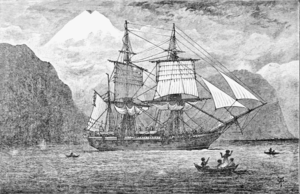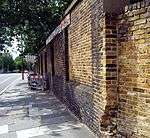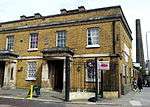Woolwich Dockyard

Woolwich Dockyard was an English naval dockyard along the river Thames in Woolwich, where a large number of ships were built from the early 16th century until the late 19th century. At its largest extent it filled a 56-acre site north of Woolwich Church Street, between Warspite Road and New Ferry Approach. The area is now partly residential, partly industrial, with remnants of its historic past having been restored.
History

Founding and early history
Woolwich Dockyard was founded by King Henry VIII in 1512 to build his flagship Henri Grâce à Dieu (Great Harry), the largest ship of its day.[1] For much of its history it was known as The King's Yard, Woolwich. Like its counterpart Deptford Dockyard, Woolwich was probably chosen for its position - on the south bank of the tidal River Thames conveniently close to Henry's palace at Greenwich. Initially situated further to the east, past Bell Water Gate, the yard moved in the 1530s-40s to what was to become its permanent site, where a pair of dry docks formed the centre of operations.

During the Age of Sail, the dockyard facilities ultimately included covered slipways for shipbuilding, masting sheers, sawmills, mould lofts, numerous storehouses (including a palatial Great Storehouse of 1693) and, in later years, a large metal-working factory used to produce anchors and other iron items. The two dry docks were rebuilt in the early 17th century (the first of several rebuildings) when the western dock was expanded, enabling it to accommodate two ships, end to end.[2]
The Ropeyard
In the 1570s a Royal Ropeyard was established in Woolwich, one of the largest in the world at the time. Too long to fit within the confines of the Dockyard, its parallel sheds lay along the line of present-day Beresford Street. It remained in service until 1750, by which time similar establishments in other Royal Dockyards had begun to come to the fore. Not long afterwards the Ropeyard suffered significant fire damage and its buildings were demolished in 1835.[3]
The Gun Wharf
As at other Royal Dockyards, the Board of Ordnance maintained a gun wharf at Woolwich for storage and provision of guns and ammunition for the ships based there. The gun wharf was sited east of the main yard, alongside what is now Bell Water Gate; the land (and wharf) was shared with the nearby Ropeyard, which maintained a storehouse there for hemp and other materials. From the 1650s the Board of Ordnance began to make use of open land further to the east, formerly used as a domestic warren, as a site for proving (and later storing) cannons and other large guns. This was the beginning of what would later become the Woolwich Royal Arsenal.
Demise and second golden age

The fortunes of the yard had waned toward the end of the seventeenth century; in 1688 its work was valued at £9,669, in contrast to nearby Deptford (£15,760), not to mention the (by now much larger) Royal Dockyards at Portsmouth (£35,045), and Chatham (£44,940).[2] In the first half of the eighteenth century, however, it gained a renewed momentum: the site doubled in size, as did the workforce, and even in the first decade of the 1700s there were more ships launched from Woolwich than from any other English yard.
Engineer Samuel Bentham was an apprentice shipwright at the dockyard during the 1770s.
The yard was further expanded westwards in the 1780s, again almost doubling in size. Much of the area of the expanded dockyard was preserved as open ground for storage of timber, with rows of wooden seasoning sheds; as the Navy's ships were growing in size and number, more raw materials were needed across the Royal Dockyards. Two new mast ponds were constructed, replacing a pond at the eastern end of the site which dated from 1720 but was now considered too small (the new ponds and mast houses could accommodate mast lengths of up to 120 feet (37 m)); the old pond, together with its associated buildings, was now given over to the construction and storage of ship's boats.
Shipbuilding continued in earnest during the Napoleonic Wars; but, as ships grew still bigger, the Thames continued to silt up. In 1802 a steam-driven bucket dredger was brought into service at Woolwich (prior to this, convicts had been used to dredge the quayside by hand) but still the silting persisted, there and at Deptford; the result being that the constrained riverside dockyards began to be wound down in favour of the ever-expanding yards at Portsmouth and Devonport.
The Steam Factory and last years of the Dockyard
From 1831, however, Woolwich found a new lease of life as a specialist yard for marine steam engineering (a relatively new technology which was being developed commercially at nearby Millwall). New buildings were constructed on the site for steam manufacturing and maintenance, including a boiler shop for manufacturing boilers, foundries for brass, copper and iron work, and an erecting shop for assembling the steam engines; by 1843 all were integrated into a single factory complex, with a single large chimney drawing on all the various forges and furnaces by way of underground flues.[4] Integral to the creation of the steam factory was the conversion of two mast ponds (which lay to the north of what is now Ruston Road) into steam basins, where ships could moor alongside the factory while their engines and boilers were fitted. One of these basins was provided with its own dry dock (No. 1 Dock) which, like the basins, was filled in and built over in the 20th century. The factory was part of the dockyard, but had a high degree of independence: it was accessed by its own gate (known as the West Gate or Steam Factory Gate) and overseen by its own official, the Chief Engineer.
Woolwich retained its primacy as the Navy's steam engineering yard through the 1840s, but following the establishment of large-scale steam yards at Portsmouth (1848) and Devonport (1853) it became increasingly redundant, especially as its basins were no longer large enough for the size of ships now being built. Older ships still came to Woolwich for engine repairs and maintenance, but by the end of the Crimean War the steam factory's days were numbered. Surprisingly though, the dockyard had managed to remain active in shipbuilding and its facilities continued to be upgraded and expanded through the 1850s and early 1860s; it could not keep pace with the emerging needs of the new ironclad warships, however, and by 1865 it was clear that both Woolwich and Deptford Dockyards were destined for closure.[2]
Closure and aftermath

Woolwich Dockyard finally closed in 1869.[5] After closure, much of the land was retained by the War office as storage space for the Ordnance Stores Department, based at the nearby Royal Arsenal. Warehouses were built across much of the site and existing buildings were converted to provide storage space. A narrow-gauge railway system served the complex, linked by way of a tunnel under Woolwich Church Street to the North Kent Line (which itself was linked into the Royal Arsenal Railway); the tunnel remains in situ for use by pedestrians.
In 1905 an Army Service Corps depot was established on the old Dockyard site (the Corps headquarters was nearby in Connaught Barracks).[6] During the First World War the site accommodated the country's largest Army Pay Office alongside the ordnance depot, as well as units of the Army Service Corps and the Army Ordnance Corps.[7]
In 1926 the western part of the site was sold to the Royal Arsenal Co-operative Society; the Co-Op still occupies a number of buildings on the site. The older, eastern portion of the site remained in Ministry of Defence hands, used for storage, workshops and offices, until the closure of the Royal Arsenal in the 1960s.[8] (The Royal Electrical and Mechanical Engineers, one of the last military units on site, moved out in 1966, taking with them the muster-bell and mast that had stood inside the main gate; it was re-erected at their depot at Arborfield, where it was rung for church services;[9] in 2016 it was scheduled to move with the corps to their new headquarters at MoD Lyneham.)[10]
Thereafter the older part of the dockyard was turned into a housing estate by Greenwich London Borough Council in the early 1970s. In the 1980s and 90s the Thames Path was extended to the area. Two towers with luxury apartments were built at Mast Quay around 2005, with even taller towers being projected in 2015.[2] The various housing projects have encroached on the historic character of the area.
Notable ships launched at the dockyard
%2C_oil_on_panel%2C_Sotheby's_sale_L09635%2C_Oct._29%2C_2009.jpg)
.jpg)

- 1512–14— Henri Grâce à Dieu (Great Harry); flagship of Henry VIII
- 1557-59— Elizabeth Jonas (the Elizabeth); fought against the Armada in 1559; rebuilt in 1597-98; broken up in 1618
- 1608— Ark Royal - a rebuilding
- 1610— HMS Prince Royal
- 1613— Defiance - a rebuilding
- 1615— Merhonour - a rebuilding
- 1616— HMS Convertine - originally begun as the private warship Destiny for Sir Walter Raleigh
- 1617— Rainbow - a rebuilding
- 1631— HMS Vanguard - a rebuilding
- 1637— HMS Sovereign of the Seas; first-rate ship of the line, ordered by Charles I
- 1655— HMS Royal Charles
- 1670— HMS Saint Andrew; first-rate ship of the line, later renamed HMS Royal Anne.
- 1751— HMS Dolphin; circumnavigated the globe twice.
- 1756— HMS Royal George; first-rate ship of the line; her sinking in 1782 was one of the worst disasters in Royal Navy history - around 800 lives were lost.
- 1783— HMS Europa - 50 gun Fourth-rate, used by Joseph Whidbey and George Vancouver to conduct a survey of Port Royal, Jamaica in 1793.
- 1805— HMS Ocean; second-rate ship of the line, flagship of Lord Collingwood.
- 1809— HMS Macedonian; frigate captured by USS United States during the War of 1812.
- 1818— HMS Talavera; third-rate ship of the line.
- 1820— HMS Beagle; ship used on naturalist Charles Darwin's famous voyage.
- 1846— HMS Niger, ship used for trials to prove the superiority of screw propulsion.
- 1852— HMS Agamemnon, the first British battleship to be designed and built from the keel up with installed steam power.
- 1868— HMS Repulse, the last wooden battleship constructed for the Royal Navy.
Heritage

On Woolwich Church Street, a late 18th-century guard house and police office with neoclassical features stand alongside the former dockyard gates. Nearby, the former office and house of the Dockyard Admiral-Superintendent now serves as the Clockhouse Community Centre; it dates from 1778-84.[11] Closer to the river, a couple of closed off docks have been preserved (and partly rebuilt) as a reminder of the area's marine significance. Two shipbuilding slips have also survived, either side of the new Mast Quay apartment blocks, and a pair of antique guns have been mounted on the quayside where a Royal Marines gun battery formerly stood.[2]

Surviving industrial buildings include parts of the old factory wall along Woolwich Church Street and remnants of the Steam Factory with its prominent chimney nearby. The original factory building of 1838 still stands on the south side of Ruston Road, although only at around two-thirds of its original length of 444 feet (135 m). When built, it housed a complex of boiler shops, a foundry, fitting shops and erecting shops for the manufacture and assembly of marine steam engines. Additions were made over the next ten years, culminating in the smithery which stands parallel with the original block, to the south; dating from 1847, this originally contained 48 hearths and 5 Nasmyth steam hammers. Coppersmiths and brass founders were accommodated in a smaller block just to the west (which is still to be seen, immediately north of the old police house at the West Gate). The building which faces the police house across the gateway was built in 1848-9 to serve as the Woolwich Dockyard School for Apprentices: one of a number of such schools set up at the Royal Dockyards under an Admiralty Scheme of 1843, Woolwich specialised in steam engineering, and for a time factory apprentices from all the royal dockyards were educated at the school.[2]
Less than half a mile to the south of the site there is a railway station called Woolwich Dockyard.
Relocated buildings
An iron-framed building of 1814 by John Rennie, removed from Woolwich in the 1970s, was re-erected at Ironbridge where it houses the Blists Hill foundry exhibit; in the dockyard it had housed Rennie's anchor forge, which was notable as the first industrial use of steam power in any naval establishment (other than for pumping water).[4] A number of metal roofs, built over shipbuilding slips at Woolwich in the 1840s and 1850s, were dismantled after the Yard closed and rebuilt at Chatham to house various manufacturing processes. One, which formerly housed a boiler shop, is now the main mall of Chatham's Dockside Outlet shopping centre.[2]
Gallery
 Main Gate (1784)
Main Gate (1784) Guard house and Master Warders's lodgings (1788-9)
Guard house and Master Warders's lodgings (1788-9)%2C_Woolwich_-_geograph.org.uk_-_198241.jpg) No. 3 Dock (rebuilt 1844-6)
No. 3 Dock (rebuilt 1844-6) No. 6 Slip (1728, later rebuilt and extended)
No. 6 Slip (1728, later rebuilt and extended) Gun battery (1847, rebuilt 1976)
Gun battery (1847, rebuilt 1976) Factory wall (rebuilt c.1840)
Factory wall (rebuilt c.1840) Police Station alongside the West Gate (1846)
Police Station alongside the West Gate (1846) Woolwich Dockyard School for Apprentices (1848-9)
Woolwich Dockyard School for Apprentices (1848-9) Warehouse (1914) dating from the site's use as a military store
Warehouse (1914) dating from the site's use as a military store 1970s housing estate
1970s housing estate Mast Quay development (2004-6)
Mast Quay development (2004-6) The Thames Path in Woolwich Dockyard
The Thames Path in Woolwich Dockyard
References
| Wikimedia Commons has media related to Woolwich Dockyard. |
- ↑ Woolwich, Encyclopædia Britannica Online Library Edition, 2010
- 1 2 3 4 5 6 7 8 Saint & Guillery, The Survey of London vol. 48: Woolwich, Yale, 2012.
- ↑ Timbers, Ken (2011). The Royal Arsenal, Woolwich. London: Royal Arsenal Woolwich Historical Society. ISBN 978-0-9568614-0-5.
- 1 2 English Heritage Survey of the Naval Dockyards
- ↑ "The Royal Dockyards of Deptford and Woolwich". Retrieved 21 August 2012.
- ↑ Osborne, Mike (2012). Defending London: the Military Landscape from Prehistory to the Present. Stroud, Gloucestershire: The History Press. p. 96.
- ↑ "Allies Here come the girls! The women volunteers at the Army Pay Office Woolwich from August to October 1914". Western Front Association. Retrieved 16 September 2016.
- ↑ "Written answers, House of Commons 1964". Hansard. Retrieved 15 September 2016.
- ↑ "Photo". Flickr.
- ↑ "The move has started...". REME Museum.
- ↑ Pevsner, The Buildings of England - London: South. Yale, 1983 & 2002.
Coordinates: 51°29′40″N 0°3′22″E / 51.49444°N 0.05611°E